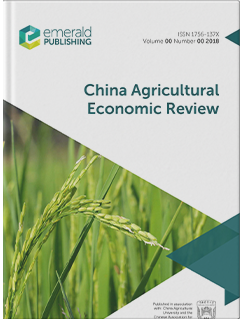中国欠发达农村地区家庭的食物需求和营养摄入:一种工具变量方法
IF 4.6
2区 经济学
Q1 AGRICULTURAL ECONOMICS & POLICY
引用次数: 0
摘要
目的通过在需求估计中纳入自产粮食和生产副作用,评估价格和收入变化对农村家庭粮食和营养需求的影响,以纠正欠发达地区农村家庭收入和价格弹性的潜在测量偏差。为经济营养安全政策的应用提供了收入和粮食价格变化对粮食和营养安全的模拟结果。设计/方法/方法本研究分析了来自中国欠发达农村地区的1555户家庭的调查数据,以了解价格和收入变化如何影响农村家庭的粮食和营养不安全。作者在两阶段预算框架中使用了二次几乎理想需求系统(QUAIDS),使用了质量调整价格,这些价格是通过回归家庭层面调查的单位价值与其村庄平均值之间的差异来检索的。偏差校正是通过使用增广IV(工具变量)方法来实现的,在该方法中,每个市场价格都用特定于农场的变量进行工具化。重要的宏观和微量营养素弹性是为(a)以农业为主要收入的家庭和(b)其他家庭(其中许多家庭仍将农业作为副业)计算的。最后,作者利用这些弹性来模拟收入或粮食价格的变化如何影响研究地区的粮食和营养安全。调查结果总体而言,农业家庭的粮食收入弹性高于其他家庭,粮食价格弹性也是如此。收入变化对农业家庭的营养影响也比其他家庭大。农业家庭的营养素收入弹性范围为0.22(能量)至0.27(维生素A),其他家庭的营养物质收入弹性范围从0.19(能量和维生素A)至0.23。粮食价格上涨对非农业家庭的营养状况影响更大,而粮食价格下跌并不明显有利于特定家庭群体的营养状况。独创性/价值这项需求研究通过考虑家庭之间自有产品消费的差异以及由此产生的潜在价格内生性,为文献做出了贡献。作者还证明,仅仅报告营养弹性可能不足以提出政策建议,模拟应该被报告为一个有价值的补充。本文章由计算机程序翻译,如有差异,请以英文原文为准。
Food demand and the nutrient intake of households in underdeveloped rural regions of China: an instrumental variable approach
PurposeThe purpose of this paper is to evaluate the effects of price and income changes on food and nutrient demand of rural households by including own-produced food and production-side effects in the demand estimation to correct potential measurement bias in the income and price elasticities for rural households in underdeveloped areas. Simulation results of income and grain price changes on food and nutrition security are provided for economic nutrition security policy applications.Design/methodology/approachThis study analyzes survey data of 1,555 households from underdeveloped rural areas of China to find out how price and income changes affect food and nutrition insecurity of rural households. The authors employ the quadratic almost ideal demand system (QUAIDS) in a two-stage budgeting framework, using quality adjusted prices that were retrieved with regressions of the difference between the unit value surveyed at household level and its village average on household characteristics. The bias correction is implemented by using an augmented IV (instrumental variable) method, in which each market price is instrumented with farm-specific variables. Important macro- and micronutrient elasticities are computed for (a) households with agriculture as main income and (b) other households (of which still many have agriculture as a side business). Finally, the authors use these elasticities to simulate how changes in income or grain prices affect the food and nutrition security in the studied areas.FindingsIn general, food income elasticities of agricultural households are at a higher level than those for other households, and so are the food price elasticities. Income changes also have a greater nutritional effect on agricultural households than on other households. Nutrient income elasticities ranged from 0.22 (energy) to 0.27 (Vitamin A) for agricultural households and from 0.19 (energy) to 0.23 (Vitamin A) for other households. Grain price increases have greater effect on nutritional status of non-agricultural households, while a grain price reduction is not clearly favoring the nutritional situation of a particular household group.Originality/valueThis demand study contributes to the literature by taking into account differences in consumption of own production between households and the potential endogeneity of prices resulting thereof. The authors also demonstrate that merely reporting nutrient elasticities might not be sufficient for policy recommendations, and simulations should be reported as a valuable addition.
求助全文
通过发布文献求助,成功后即可免费获取论文全文。
去求助
来源期刊

China Agricultural Economic Review
AGRICULTURAL ECONOMICS & POLICY-
CiteScore
9.80
自引率
5.90%
发文量
41
审稿时长
>12 weeks
期刊介绍:
Published in association with China Agricultural University and the Chinese Association for Agricultural Economics, China Agricultural Economic Review publishes academic writings by international scholars, and particularly encourages empirical work that can be replicated and extended by others; and research articles that employ econometric and statistical hypothesis testing, optimization and simulation models. The journal aims to publish research which can be applied to China’s agricultural and rural policy-making process, the development of the agricultural economics discipline and to developing countries hoping to learn from China’s agricultural and rural development.
 求助内容:
求助内容: 应助结果提醒方式:
应助结果提醒方式:


